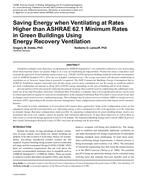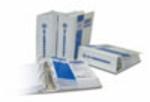Description
Ventilation at higher rates than those recommended by ASHRAE Standard 62.1 are sometimes utilized as a way of providing better-than-baseline indoor air quality (IAQ) or as a way of remediating an IAQ problem. Productivity data is sometimes used to justify the approach. Green building rating systems (e.g., USGBC-LEED) and green building standards still under development such as ASHRAE Standard 189.1, drive the use of higher ventilation rates. The energy associated with thermal-conditioning of ventilation air is, however, larger than is generally recognized. The DOE Commercial Buildings Energy Consumption Survey (CBECS) Ventilation category represents only the fan energy used to move ventilation air, not the energy to condition outdoor air. Such conditioning can amount to about 30% of HVAC energy, depending on the type of building and its local climate. Several options will be discussed for reducing the amount of energy that would be used in conditioning this additional ventilation air. If the IAQ Procedure (Alternate Ventilation Rate Procedure) is adopted, then a local purification device can be used to obtain equivalent air quality by removal of contaminants. If the standard Ventilation Rate Procedure is used, an air-to-air heat exchanger can be used to recover conditioning energy. This exchanger may be a heat-recovery ventilator (HRV) or energy recovery ventilator (ERV), depending on the need for moisture management. Some configurations analyzed include bypass and economizer features. The results of system simulations to be presented will compare these approaches.
Some of the configuration issues are the equipment sizing and the associated first cost. Operating energy is also considered in a life-cycle approach, as is the reduction in demand charges that some configurations make possible. In comparing configurations for green building design, metrics are needed for life-cycle cost, comfort, indoor air quality, and ventilation effectiveness. To meet these objectives as well as those in other areas a concurrent design approach is known to be helpful. The Integrated Building Energy and Controls (IBECS) process that United Technologies Research Center (UTRC) has been developing will be described.
IAQ 2007 Conference held in Baltimore, Maryland, October 14-17, 2007
Units: Dual
Citation: IAQ Conference: IAQ 2007: Healthy and Sustainable Buildings
Product Details
- Published:
- 2008
- Number of Pages:
- 8
- File Size:
- 1 file , 310 KB
- Product Code(s):
- D-IAQ2007-30




